
About UsThe Numismatic Bibliomania Society is a non-profit organization promoting numismatic literature. For more information please see our web site at coinbooks.org SubscriptionsThose wishing to become new E-Sylum subscribers (or wishing to Unsubscribe) can go to the following web page link MembershipThere is a membership application available on the web site Membership Application To join, print the application and return it with your check to the address printed on the application. Membership is only $15 to addresses in the U.S., $20 for First Class mail, and $25 elsewhere. For those without web access, write to: David M. Sundman, Secretary/TreasurerNumismatic Bibliomania
Society AsylumFor Asylum mailing address changes and other membership questions, contact David at this email address: dsundman@LittletonCoin.com SubmissionsTo submit items for publication in The E-Sylum, just Reply to this message, or write to the Editor at this address: whomren@coinlibrary.com
BUY THE BOOK BEFORE THE COINYou won't regret it! |
- WAYNE'S WORDS: THE E-SYLUM OCTOBER 17, 2010
- WANTED: COIN BOOK IMAGES FOR NBS BIBLIOGRAPHY
- NEW EDITION: STANDARD CATALOG OF U.S. PAPER MONEY, 29TH EDITION
- ARTICLE PROFILES MEDALLIC ARTIST IVANKA MINCHEVA
- 1968 OLYMPIAN TOMMIE SMITH OFFERS GOLD MEDAL FOR SALE
- ON COUNTERFEITING AND ANTI-COUNTERFEITING
- THE NEVADA EXHIBIT AT THE 1876 PHILADELPHIA CENTENNIAL EXHIBITION
- ON MENSA AND WALTER BREEN'S IQ
- QUERY: INFORMATION ON OWL COUNTERMARK SOUGHT
- MEDAL 'STOLEN VALOR' LAW HEADED FOR SUPREME COURT
- NUMISMATIC GLEANINGS FROM CONTEMPORARY NEWSPAPERS
- COIN DESIGNER JAMIE FRANKI TO SPEAK AT OCTOBER 2010 PAN SHOW
- TWO-CENT PIECE AUTHOR KLIMAN ARRESTED
- RON GUTH'S TRIP TO DAHLONEGA
- ARTICLE PROFILES COIN DEALER BELINDA DOWNIE
- PHOTO: ROMAN GOLD COINS FOUND IN GERMANY
- NOTES FROM E-SYLUM READERS: OCTOBER 17, 2010
- FEATURED WEB PAGE: AUSTRIAN ENGRAVERS
WAYNE'S WORDS: THE E-SYLUM OCTOBER 17, 2010

Among our new subscribers this week are Mr Quoc Hoang Nguyen, owner of Saigon Coin in Ho Chi Minh City and Mr Ron Richardson, owner of Columbia Notes in Vancouver, BC, Canada, both courtesy of Howard Daniel, Frank Trask, courtesy of John and Nancy Wilson, and Andrew Meadows. Welcome aboard! We now have 1,371 subscribers.
This week we open with a request for assistance with the NBS bibliography project followed by an announcement of a new book from Krause Publications on U.S. paper money. Next up are two articles related t medals - one about a contemporary medal artist, the other about the sale of a famous Olympic gold medal.
Other topics this week include an intriguing Owl countermark, the Stolen Valor Act, contemporary accounts of the 1794 dollar and the 1829 U.S. Mint cornerstone, and Australian dealer Belinda Downie. To learn about Dr. Charles Spier, medal artist Ivanka Mincheva and Walter Breen's IQ, read on. Have a great week, everyone!
Wayne Homren
Numismatic Bibliomania Society
WANTED: COIN BOOK IMAGES FOR NBS BIBLIOGRAPHY
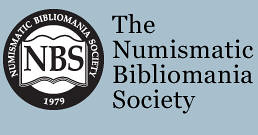 Tom Wetter has been working hard to build a top-notch online bibliography of American numismatics on the Numismatic Bibliomania Society web site. To finish it, he needs your help. He's created a web page listing the editions he requires images of to complete the first part of the bibliography, The One Hundred Greatest Items of United States Numismatic Literature.
Tom Wetter has been working hard to build a top-notch online bibliography of American numismatics on the Numismatic Bibliomania Society web site. To finish it, he needs your help. He's created a web page listing the editions he requires images of to complete the first part of the bibliography, The One Hundred Greatest Items of United States Numismatic Literature.
See the link below. Because NBS aspires to have images of every edition of each of the books (even reprints) in the bibliography, it's a lengthy list. But that makes for a target-rich environment where any one of us has an opportunity to chip in. Items from your numismatic library could be the "plate books" on the site.
Here's a VERY short excerpt from the beginning of the list. Please click on the link below to review the complete list. Please help out if you can - we NEED your contributions to make this project a success.
#2 - Early Coins Of America
1875 Lyman Low Binding
1970 Burt Franklin Reprint
1974 Quarterman Reprint, with and without dust jacket.
1983 Quarterman Reprint, without dust jacket.
1990 Durst Reprint
#4 - A Guide Book Of United States Coins
6th Edition, 1953-1954
9th Edition, 1956
10th Edition, 1957
#5 - Penny Whimsy
1st Edition, with and without dust jacket.
1965 Ford Reprint, with and without dust jacket.
1965 Krause Reprint, with and without dust jacket.
1976 Quarterman Reprint, with and without dust jacket.
1990 Durst Reprint, with and without dust jacket.
To read the complete list, see: Images needed to complete the Top 100 NBS Survey (wiki.coinbooks.org/index.php/Top_100_Images_Needed)
NEW EDITION: STANDARD CATALOG OF U.S. PAPER MONEY, 29TH EDITION
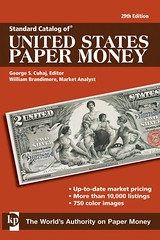 The 29th edition of the Standard Catalog of United States Paper Money is now available from Krause Publications.
The 29th edition of the Standard Catalog of United States Paper Money is now available from Krause Publications.
This guide is the most comprehensive catalog of U.S. federal currency, and features 750 high-quality color photographs for easy and accurate of identification of notes. The color photographs in this guide also make it a valuable tool for assessing the condition of notes, providing a crisp and clean example to compare against.
Compiled by market analyst William Brandimore and editor George S. Cuhaj, this Standard Catalog lists current market values in up to four condition grades for 10,000 listings of notes, including:
-Large and Small Size Currency
-Silver and Gold Certificates
-National Bank Notes by State
-Pre-Civil War Treasury Notes
-Fractional Currency
-Military Payment Certificates
For more information visit
www.shopnumismaster.com/product/standard-catalog-of-
united-states-paper-money-29th-edition/us-paper-money
.
George S. Cuhaj is an accomplished collector and researcher who also is the editor of numerous numismatic references, including the Standard Catalog of World Paper Money. William Brandimore brings nearly 20 years of paper money collecting experience to this effort, and has held positions of leadership in state and regional paper money collecting associations.
Working on the SCUSPM editions with Bill Brandimore has been a pleasure. Bill does pricing updates (which appear monthly in Bank Note Reporter) and we work together to check the new variety listings (Series, Districts, star notes and printing facilities) for new releases.
Bill has a inquisitive approach to collecting and I think that refreshing. Throughout the year the price changes are input to the database by Kay Sanders. The other constant in the production of the book is that of our designer, Sandy Carpenter (formerly Morrison) who has worked on all four color editions. It makes for a production knowledge that makes the process go smoothly.
In addition to editorial modifications (the text is run from a data base) I get to enhance the color photographs. We started with photographing Chet Krause's collection before it was sold. For the 30th edition I am working with Douglas Mudd at the ANA to use some of the Beebee collection note images in areas where major types are still lacking.
Through a large amount of hard work in the off-production period, the book has progressed a long way in the past four editions since the last of the 24-year run of 8.5x11 format green hard covered b/w interior editions.
George adds:
This fall - soon - like around Thanksgiving, a Canadian Coin Book, a 18th Century Coin Book and the German States Book all will be hitting the shelves. We have been very very busy!
THE BOOK BAZARRE
“Buy the Book About the Book Before You Buy the Book!”ARTICLE PROFILES MEDALLIC ARTIST IVANKA MINCHEVA
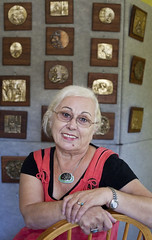 Ivanka Mincheva was just a little girl of 6 or 7 years old when she set out from school on what would be a life-changing mission.
Ivanka Mincheva was just a little girl of 6 or 7 years old when she set out from school on what would be a life-changing mission.
Needing clay for a classroom art project, she began looking for it on her own, scouring the back lots of her concrete and brick neighborhood in urban Sofia, Bulgaria, in a single-minded pursuit of the mysterious substance.
Once she found a suitably pliable puddle of mud, Mincheva reached down and began forming it into shapes with her fingers. So engrossed did she become that she couldn't stop, and she played with the wonderfully supple material for hours.
More than 50 years later, the Yorktown woman is a medallic sculptor of international renown — with works in such places as the Hermitage Museum in St. Petersburg, the Pushkin Museum in Moscow and the British Museum in London. She recently won the 2010 Numismatic Art Award for Excellence in Sculpture from the American Numismatic Association.
Despite her classical training, however — and years of working alongside some of medallic sculpture's most important artists — Mincheva still looks back on her unexpectedly ardent session with a Sofia mud puddle as one of her most formative moments.
"My parents panicked when I didn't come home," she recalls.
"When they finally found me I was still playing in the wet mud — and I still love the feeling of it today. I can't get enough."
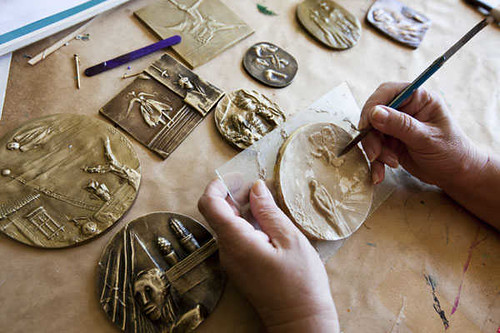
Mincheva's training was intensive — with drawing and modeling classes every day. But after six years she graduated with such an accomplished portfolio of studio work — not to mention her exceptional knowledge of anatomy, art history and aesthetics — that she quickly became a much sought-after working artist.
Within a few years, she'd won numerous commissions for monumental outdoor works commemorating her country's history and culture. But despite her growing renown for such impressive pieces, her secret passion lay in the much smaller things she habitually carved in her kitchen.
"I was well-paid for these large sculptures. But I quickly realized it was not for me," she says.
"I was only 110 pounds — and the biggest pieces wore me out. They also took months and months to do — and I was always struggling to put off my other ideas so I could complete them."
Mincheva found the answer to her dilemma when friends introduced her to a Russian-trained Bulgarian artist who excelled at small-scale medallic sculpture. Soon she ranked alongside him in this intimate yet compelling art form, earning a place at a 1982 international symposium that exposed her distinctive, often haunting images to critics, collectors and museums across Europe.
Soon her medals were being celebrated by such authorities as British art historian Terence Mullaly, who tapped a 1988 work titled "The Visitor" as one of the finest examples of the form created in the late 1900s. Sir Mark Jones, former curator at the British Museum and then director of the Victoria and Albert Museum in London, admired Mincheva's distinctive talent just as strongly.
"Her hauntingly poetic and beautifully modeled medals make a deep and resonant impact on those who are lucky enough to see or, better still, handle them," he wrote.
Despite the subsequent stream of commissions and awards, Mincheva's artistic and financial success couldn't compensate for a lingering sense of incompleteness. For years she had been waiting for a man, she says, and many of her images — including "The Visitor" — reflect her loneliness.
That pain came to an end when she began receiving letters of admiration from a Bulgarian-born American musician who played violin for the Virginia Symphony in Norfolk. "It was instant chemistry," she says, describing months of increasingly ardent correspondence and finally meeting at the opening of one of her shows in London.
"We were married in 1992 and lived in Bulgaria for a year. Then he became homesick for the States," Mincheva says. "My friends told me I was crazy to leave. I was somebody in Bulgaria, and when I came here I had to start from scratch. It was quite a culture shock."
"People here don't know this kind of art well. But they show their appreciation more openly — and that's been very inspiring. It's given me more freedom in my work," she says.
"I'm an American sculptor now."

"Daedalus and Icarus"
To read the complete article, see:
Yorktown woman wins world renown for medallic sculpture
(www.dailypress.com/entertainment/galleriesandmuseums
/dp-fea-medalartist-20101016,0,4910672.story)
1968 OLYMPIAN TOMMIE SMITH OFFERS GOLD MEDAL FOR SALE
 The news was jarring and slightly unbelievable. Tommie Smith, the former Olympic champion, was auctioning his gold medal.
The news was jarring and slightly unbelievable. Tommie Smith, the former Olympic champion, was auctioning his gold medal.
Of all people, Smith — a proud, disciplined, principled man.
But there it was plain as day, on the Web site for the auctioneer, Moments in Time Memorabilia, the iconic photo of Smith, Peter Norman and John Carlos, the gold, silver and bronze medal winners of the 200-meter race at the 1968 Summer Olympics in Mexico City.
Carlos and Smith stood, heads bowed, black gloves thrust skyward as the United States flag was raised with the playing of the national anthem.
This remains one of the most recognized demonstrations of protest and resistance in the history of United States athletics, and it was the perfect symbol of a generation. Why would Smith, 66, want to sell anything associated with this historic moment? Especially his gold medal?
For many of us, the gesture became an inspirational symbol of defiance. For Smith and Carlos, who suffered tremendously — they couldn't find employment and received constant threats and hate mail — the medal became the symbol of a nightmare.
Perhaps by selling it, Smith will find closure, though the reality is he and Carlos will forever be defined by that moment.
What is the value of Smith's medal? Some sports auction houses like Gold Medal Collectables in Ontario, Canada, estimate that it might sell for $8,000 to $10,000.
Zimet said the bidding would start at $250,000.
Dr. Walter Evans, a prominent art collector with one of the world's largest collections of African American artifacts, said that for those who collect in this genre, Smith's medal has high value.
“I don't collect sport memorabilia, but if I were interested in that type of artifact I would pay a quarter of a million for it,” he said by telephone Thursday. “He's a historical figure. It's not Martin Luther King or Malcolm X, but all of those things combined helped to change the course of our history.”
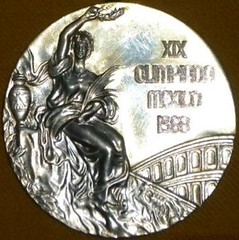
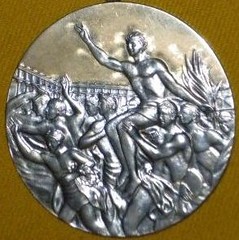
Smith would not comment on the proposed sale, but his wife, Delois, said by telephone Thursday, “If it doesn't bring the amount that Tommie has in mind, believe me, it will not be sold.”
Smith should be wise about selling his gold medal and shoes. Yes, the medal is his, but it has been cherished for generations by many who remember the moment and many more who have seen the footage.
The gesture was among the three most defining events in the social and political history of sports in the United States — along with Jackie Robinson's stepping forward to desegregate Major League Baseball and Muhammad Ali's refusing to step forward to serve in the army.
Smith and Carlos raised clenched fists in a silent yet powerful gesture.
Now Smith wants to cash in.
In an ideal world, someone, perhaps a contemporary athlete who is a collector, would buy Smith's gold medal and his shoes and give them back — as a gift.
Integrity should not — must not — be for sale.
Smith should know.
Wasn't that the point?
To read the complete article, see: For Sale: A Medal Worth More Than Gold (www.nytimes.com/2010/10/16/sports/16rhoden.html)
To view the auction lot description, see: TOMMIE SMITH'S 1968 OLYMPIC GOLD MEDAL AND 200M WORN PUMAS (momentsintime.com/Tommie%20Smith.htm)
THE BOOK BAZARRE
ON COUNTERFEITING AND ANTI-COUNTERFEITING
Joe Boling writes:
That's exactly why the $5 note underwent the colonizing process, and along the way the watermark of Lincoln was replaced by watermarks that say "5" and "FIVE" several times. Actually, the watermark of Lincoln was a much better match for the watermark of Grant in the $50 note, but once the fraudsters got the notes cleaned off, turning them into $100s was more profitable.
One day I watched a cash register clerk holding a note up to the overhead lights in a Dollar Store in Federal Way, WA. I asked if she was checking for the watermark. She replied no, she was checking to see that the watermark matched the portrait. Pretty savvy - the only person I've ever encountered who did that. They usually just swipe that ubiquitous yellow marker across the note. (That same store would do that to my $2 bills, every time.)
On another occasion I was paying my bill at the Denny's down the road from the Crowne Plaza in Rosemont, and suddenly the clerk was bathed in intense blue light from the waist down. She had a very powerful UV light under the counter, and was checking the reactions of the polymer strips in the notes that I had handed her. That's the only time I have seen that behavior, also.
At least some clerks are getting training in security features other than that d....d yellow pen.
To read the earlier E-Sylum articles, see:
NOTES FROM JOE BOLING: OCTOBER 10, 2010
(www.coinbooks.org/esylum_v13n41a16.html)
COUNTERFEITER CAUGHT MAKING $5 BILLS INTO $100S
(www.coinbooks.org/esylum_v13n41a28.html)
THE NEVADA EXHIBIT AT THE 1876 PHILADELPHIA CENTENNIAL EXHIBITION
I know almost nothing about the overall use of Nevada bullion in the Mints, but I can add some information about some Nevada bullion produced in the Nevada exhibit at the 1876 Centennial Exhibition in Philadelphia. Here is an excerpt from the draft of my book that may be germane:
“In 1873, a select committee of influential businessmen and local politicians recommended to the state government in Carson City that the state of Nevada should consider participating in the great Centennial Exhibition in Philadelphia in 1876. The Comstock Lode in Virginia City had just produced record amounts of silver and gold, and it was a matter of great pride to trumpet the success of the state's mines and good business to expand the market in Nevada silver and gold.
“The state legislature appropriated $20,000, the fourth largest appropriation among the states, behind only Pennsylvania, Massachusetts, and New York. The sum was so generous that the committee decided to erect a quartz stamp mill to demonstrate the transformation of Comstock ore into refined silver and gold. To this end, tons of roughly crushed ore were shipped by rail over the three thousand miles to Philadelphia, where exhibition visitors could see for themselves the almost magical process of turning nondescript stone into gold and silver, almost before their very eyes.
“Upon entering Machinery Hall, visitors could hear the Nevada exhibit before they ever saw it. Five 775-pound hammers took turns dropping from a height of eight inches ninety-five times every minute, reducing the incoming ore to gravel. The gravel was then carried in a stream of water to the stampers, 120-pound steel dies and shoes that smashed the gravel into a great cast-iron mortar, until it could sift through fine screens as fine as 120 holes per square inch. After settling, the sand slurry was fed into grinders, where the mixture spent three hours turning into putty. Then, mercury was added and a process of amalgamation went on for another four and a half hours.
“Once the water was filtered out, the silver-gold-mercury amalgam was heated, splitting out the gaseous mercury for reuse, and concentrating the gold and silver into bullion to be sent to the U.S. Mint, where it was smelted into pure ingots. The silver was used to strike the Nevada silver Centennial medals, and the gold defrayed the expenses of minting the silver and bronze medals. The finished medals were then sold in the California and Nevada Building on the exhibition grounds.
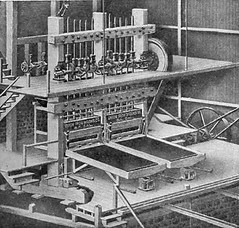 “The quartz mill at the exhibition could process twenty tons of ore in a single day, and $200 worth of silver and gold (about 130 Troy ounces at 1876 prices) were extracted from each ton, for a maximum total of 2,600 ounces per day. That means that the mill could have produced a maximum of about 413,400 Troy ounces during the course of the Centennial Exhibition in the 159 open days between May 10 and November 10, 1876. Since Mint records indicate that 2,531 of the silver medals were struck using only 2,010 Troy ounces, it is clear that the mill was more than capable of supplying all the silver required for the entire run of silver medals, with plenty left over to fund the entire operation. The actual final total output of the operation is unknown, but it is unlikely that the crusher worked at full capacity for an entire day.”
“The quartz mill at the exhibition could process twenty tons of ore in a single day, and $200 worth of silver and gold (about 130 Troy ounces at 1876 prices) were extracted from each ton, for a maximum total of 2,600 ounces per day. That means that the mill could have produced a maximum of about 413,400 Troy ounces during the course of the Centennial Exhibition in the 159 open days between May 10 and November 10, 1876. Since Mint records indicate that 2,531 of the silver medals were struck using only 2,010 Troy ounces, it is clear that the mill was more than capable of supplying all the silver required for the entire run of silver medals, with plenty left over to fund the entire operation. The actual final total output of the operation is unknown, but it is unlikely that the crusher worked at full capacity for an entire day.”
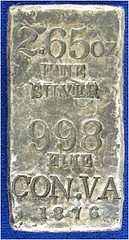 “It is probable that some of the output from the mill in the form of bullion ingots was placed on display both at the exhibit in machinery Hall and in the California and Nevada Building, where the medals were sold. None of these original ingots produced at the exhibition are known to have survived, but two ingots produced in Nevada and shipped to the exhibition are known to exist. One was smelted at the Belcher mine and the other with silver from the Consolidated Virginia mine, both of which extract bullion from the Comstock Lode in Virginia City. These are thought to be the only such marked survivors of the Centennial, with the possible exception of uncataloged and, thus, unknown ingots in institutional collections.
“It is probable that some of the output from the mill in the form of bullion ingots was placed on display both at the exhibit in machinery Hall and in the California and Nevada Building, where the medals were sold. None of these original ingots produced at the exhibition are known to have survived, but two ingots produced in Nevada and shipped to the exhibition are known to exist. One was smelted at the Belcher mine and the other with silver from the Consolidated Virginia mine, both of which extract bullion from the Comstock Lode in Virginia City. These are thought to be the only such marked survivors of the Centennial, with the possible exception of uncataloged and, thus, unknown ingots in institutional collections.
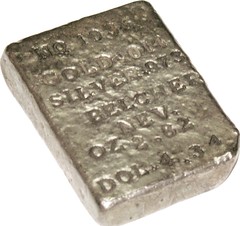
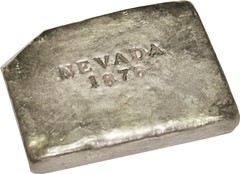
“The Belcher ingot is individually letter punched with “NO. 1036 // GOLD .014 // SILVER .973 // BELCHER // NEV. // OZ 2.82 // DOL. 4.34” The reverse is similarly stamped : NEVADA // 1876. The Consolidated Virginia ingot is cast with the inscription: “2.65 OZ // FINE // SILVER // 998 // FINE // CON.VA // 1876.” The word “silver” was originally cast upside-down, so it was later over-stamped correct side up, which accounts for the apparent doubling at that point.”
I have no idea whether these 2000+ ounces of silver appeared in Mint records of Nevada bullion, or whether it represents an amount even worth considering.
To read the earlier E-Sylum article, see: QUERY: CALIFORNIA REFINERS OF NEVADA BULLION SOUGHT (www.coinbooks.org/esylum_v13n41a19.html)
ON MENSA AND WALTER BREEN'S IQ
Ginger Rapsus writes:
Thanks for the latest issue! Have you ever figured out how many hours a week you spend getting an issue together? It's quite a job, I'm sure.
Not to nitpick, but...The word Mensa is not an acrostic, and should not be in all caps. Mensa is a Latin word; I believe the word for table. There is a constellation Mensa in the Southern sky. I used to belong to Mensa, many years ago, but I do no longer.
David Fanning writes:
Several discussions on the E-Sylum over the years (including recent ones) have mentioned Walter Breen's IQ. This information exists in Breen's military records.
On October 3, 1946, Breen enlisted in the Army Air Force for a period of three years at Kelly Field in San Antonio, Texas. Why he was accepted at this time when turned away on a previous attempt to enlist in April is unclear. He was sent to the San Antonio Aviation Cadet Center (soon to be renamed Lackland Air Force Base) for training. On entering the military, his personal information was recorded as follows:
Height: 6 feet, 1 inch
Eye color: hazel
Hair color: brown
IQ: 144
Vision: 20/20-20/15
The September 5, 1928 birth date was used when he enlisted and he apparently listed his “mother” as a dependant. His military identification number was 18 324 478. The records documenting the above are in the possession of Breen's remaining family.
An IQ of 144 is very high, and is generally regarded as being as a 99.8% percentile ranking. (Note there are different IQ tests resulting in different percentile rankings, though these differences tend to evaporate at these elevated levels). IQ measurements above 200 are generally held to be apocryphal, with differences above 150 or so being very difficult to detect via standard testing (and frankly mostly irrelevant). Breen was a member of Mensa, though I don't know how active he was in the organization. Breen's daughter Moira is an active member.
To read the earlier E-Sylum article, see: CHIPPING AWAY AT B. MAX MEHL'S COST CODE (www.coinbooks.org/esylum_v13n41a15.html) To read the complete article, see: ()
QUERY: INFORMATION ON OWL COUNTERMARK SOUGHT

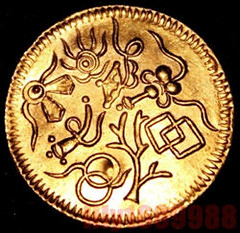
This is the second time I have seen this gold Vietnamese Emperor Minh Mang (1820-40) presentation piece offered on eBay. It is now under item number 170537328789. The seller resides somewhere in China. In my opinion, the piece is a modern copy for several reasons but I will not describe why here at this time.
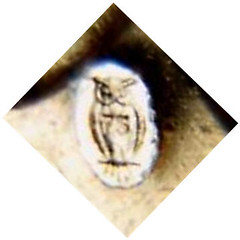 The VERY interesting detail on this coin is an owl countermark at around 5 o'clock on the obverse side that almost touches the (bottom) Mang character. It does not look like anything I have seen for a Chinese countermark, but it is very much like a mintmaster and engraver mark found on French coins.
The VERY interesting detail on this coin is an owl countermark at around 5 o'clock on the obverse side that almost touches the (bottom) Mang character. It does not look like anything I have seen for a Chinese countermark, but it is very much like a mintmaster and engraver mark found on French coins.
Many modern copies of Vietnamese presentation pieces were made in Paris, so there might be a connection. Does anyone recognize this owl countermark? Has anyone seen it on other Vietnamese pieces or other pieces?
To view the eBay item, see: Vietnam Ming Ming 1820-41 Gold coin 1-1/2 Tien Rare (http://cgi.ebay.com/ws/eBayISAPI.dll?ViewItem&item=170537328789)
THE BOOK BAZARRE
NOVEMBER 18, 2010 AUCTION SALE HIGHLIGHTSA Pivotal 1764 Parliamentary Act Regulating
American Colonial Currency
This rare Act was one of the most threatening to American paper currency
and, as Eric Newman notes, the economic policies prescribed
in the Act interfered with the ability of the American colonists
to engage fruitfully in trade and, as a result, comprised part
of the justification for the American Revolution
KOLBE & FANNING NUMISMATIC BOOKSELLERS
141 W JOHNSTOWN ROAD, GAHANNA OH 43230-2700
(614) 414-0855 • df@numislit.com • GFK@numislit.com
MEDAL 'STOLEN VALOR' LAW HEADED FOR SUPREME COURT
Recently in two courts, one in California and one in Colorado, have ruled against a federal law outlawing lying about medals a person has won. The judges apparently considered that the First Amendment allows a person to say whatever they want. Veteran groups, on the other hand, are taking the opposite view that it is diminishing the valor bestowed on legitimate war heroes.
The Stolen Valor Act, passed in 2005, prohibits such actions. Over 40 people have been charged under this act since then, but only two have been prosecuted and punished. It seems inevitable these recent cases are headed for a Supreme Court Decision.
We have an attorney general here in Connecticut who is being accused of violating this very act. See
waronterrornews.typepad.com/home/2010/10/
stolen-valor-ag-richard-blumenthal.html
This act does not affect medal collectors or dealers in handling medals. Breathes there a medal enthusiast, however, who has not pinned a decoration from his collection on his own tunic, or placed a medal on a ribbon around his own neck? But this is not a violation of the law, he is not purporting to have won this medal. It might be a fine line, I suspect, but once such a person steps out of his home or office wearing a medal and someone of the public sees this it might be considered a violation.
The E-Sylum has run a number of articles on this previously. Latest: March 21, 2010 (vol 13, no 12, art 24)
Here is the article on this week's two actions: Preserving 'Stolen Valor Act' (www.onenewsnow.com/Legal/Default.aspx?id=1207586)
To read the earlier E-Sylum article, see: STOLEN VALOR: AN EDITORIAL (/www.coinbooks.org/esylum_v13n12a24.html)
NUMISMATIC GLEANINGS FROM CONTEMPORARY NEWSPAPERS
As many of you have noticed in the recent ad for the upcoming Kolbe & Fanning sale, I'm selling much of my collection of newspapers containing articles relating to numismatics. I'll miss having them, but I'm sure they'll go to good homes. Dave Fanning did a great job of cataloging them, and at my request he provided a few examples for The E-Sylum.
I collected most of these over about a twelve-year period beginning around 1985. Those were the pre-Internet days, and I had gotten onto the mailing lists of multiple dealers who handled these. In those days libraries were on a deacquisition binge, selling off tons of newspaper holdings that had been converted to microfilm.
Bad idea in my opinion, but their loss was the collector's gain. The dealers combed the papers for interesting articles on topics of interest to public. I was an eager buyer for newspaper issues containing one or more articles on numismatic topics. I didn't buy everything that came my way, or my house would have filled to the rafters. But I chose what I thought were particularly interesting or significant numismatic topics. Here are a few representative examples.
Lot 324: A 1794 Account of the 1794 Dollars
COLUMBIAN CENTINEL. Vol. XXII, No. 23 (Wednesday, Nov. 26, 1794). Boston: Published by Benjamin Russell. Tabloid. 4 pages. Very good. (400.00)
A remarkable newspaper with an important article giving a first-hand account of the 1794 dollar in the year it was minted: “Some of the Dollars now coining at the mint of the United States, have found their way to this town. A correspondent put one into the Editor's hands yesterday. Its weight is equal to that of a Spanish dollar, but the metal appears finer. ... The tout ensemble has a pleasing effect to a connoiseur [sic]; but the touches of the graver are too delicate, and there is a want of that boldness of execution which is necessary to durability, and currency. They will be improved upon.” Very important.
Everybody's a critic. But who wouldn't want to be handed a brand-spanking new 1794 Dollar today?
Lot 345: Foundation Stone of the Mint
WESTERN ANNOTATOR. Vol. III, No. 13 (Aug. 1, 1829). Salem, Indian: Published by J. Allen & W. Tannehill. Tabloid. 4 pages. Leaves neatly separated at spine. Some tape repairs at fold. Hand-written address. Very good. (75.00)
A scarce early Indiana newspaper with a brief article on counterfeits on page 2 and a longer, more substantive article on page 3 about the construction of the new Mint building and the contents deposited in its foundation stone (including “species of the national coins, including one of the few executed in the year 1792 the first of the new emission of that coin, of which denomination none have been issued since 1805”).
OK, raise your hands - who would like to get their mitts on THAT Time Capsule? I asked Len Augsburger (co-author with Joel Orosz of the upcoming book on Frank Stewart and the First Philadelphia Mint), who writes: "We had the following in our book (below). Looks like the Indiana newspaper picked up the account from the Philadelphia papers. So far as I know, none of the O'Brien coins are attributed today. A search of the Chapman catalogs c. 1903-1904 might reveal something."
Equally prized might be the cornerstone of the second United States Mint, laid July 4th, 1829. The three hundred pound stone protecting a candy jar with its contents was unearthed circa 1903 and reported in the The Numismatist that year.[i] The find reportedly included an 1829 dime, an 1829 half-dime, said to be the very first struck in that year, and an unidentified coin of the first year of the Mint, “one of the very few executed in the year 1792,”[ii] probably a half disme. Another account mentioned an 1828 cent and half cent, and a “valuable penny,” possibly a 1792 Birch or silver center cent.[iii]
Curiously, one of the workers put his hand in the candy jar and quietly made off with the precious jug during the excavation. Later reported to authorities, one Thomas O'Brien escaped prosecution on the grounds that the government could not produce a definitive inventory of the cornerstone contents, and to this day none has been located outside of inconsistent press accounts. O'Brien in fact returned some of the loot, but no one could prove what did or did not remain from the original cache.[iv]
[i] The Numismatist, Vol. 16, No. 5, May, 1903, 148.
[ii] The Register of Philadelphia, 7/11/1829, 28. Also see Coin World, 4/20/2008, 20, and Niles' Register, 7/18/1829.
[iii] Nancy Oliver and Richard Kelly, “What was Stolen from Former Mint Cornerstone?,” Coin World, 4/27/2009, 1, 5.
[iv] Ibid.
Lot 361: A Coin Lunatic
GOLD HILL DAILY NEWS. Vol. XIX, No. 2834 (Thursday, Jan. 9, 1873). Gold Hill, Nevada: Published by Alf. Doten. Large tabloid. 4 pages. Hand-addressed. Very good. (100.00)
An early Nevada newspaper, containing an article on Dr. Charles Spier (with the charming title given above), described within as “the oldest living and most successful numismatist in the world.” The article gives an account of some of his treasures. Very rare.
I'm hoping that the winner of this lot will write the article on Dr. Spier that I always wanted to pen for The Asylum but never quite got around to doing. Somewhere in my library I've got a catalog of his collection. He was an interesting early California collector who's fairly unknown today but was known far and wide in his day.
To view the complete Kolbe & Fanning catalog online, see: Auction Sale One Hundred Nineteen (www.numislit.com/Sale%20119/SALE%20119.pdf)
COIN DESIGNER JAMIE FRANKI TO SPEAK AT OCTOBER 2010 PAN SHOW
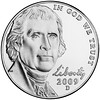 Jamie Franki will be here to speak on Saturday at 2PM to an expected 150 kids and parents. He'll give the YN version of the fascinating talk he gave in the Numismatic Theatre in Boston on Paul Revere and the making of the ANA medal. As usual he'll find ways to give away signed Jefferson Nickels with his buffalo on the reverse.
Jamie Franki will be here to speak on Saturday at 2PM to an expected 150 kids and parents. He'll give the YN version of the fascinating talk he gave in the Numismatic Theatre in Boston on Paul Revere and the making of the ANA medal. As usual he'll find ways to give away signed Jefferson Nickels with his buffalo on the reverse.
Jamie will be in the PANKIDZONE where YNs get giveaways and fill penny boards with wheat cents and Jefferson Nickels all day on Saturday. Immediately following his presentation the kids will participate in our 50-lot auction of great numismatic material bid on with PAN dollars that they receive.
That evening he'll be our after dinner speaker at the PAN banquet in the Radisson, Monroeville beginning at 6PM. Tickets for the banquet are only $30 and can be reserved by emailing Skip Culleiton at skipcull@verizon.net.
For more information on the PAN show, see: www.pancoins.org
THE BOOK BAZARRE
TWO-CENT PIECE AUTHOR KLIMAN ARRESTED
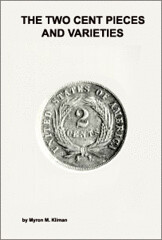 A penny for your thoughts? Myron Michael Kliman, a 77-year-old coin dealer from Laguna Niguel, wrote the book on them.
A penny for your thoughts? Myron Michael Kliman, a 77-year-old coin dealer from Laguna Niguel, wrote the book on them.
But police aren't sure what he was thinking when he was arrested following a knife attack Saturday night.
Police were called at 8:40 p.m. to the 24900 block of La Plata Drive. Kliman's neighbor told police her husband had been assaulted when his hand was cut with a knife.
According to the police supervisor's log, neighbor Sean Harper was confronted at home by Kliman over a pine needle dispute.
After detaining both men, police arrested Kliman, author of "The Two Cent Pieces and Varieties."
He was later released after posting an undisclosed bail.
To read the complete article, see: Coin collector, 77, arrested after knife attack (www.ocregister.com/news/police-270930-knife-kliman.html)
RON GUTH'S TRIP TO DAHLONEGA
 Yesterday, I got to enjoy a little numismatic “dream come true.”
Yesterday, I got to enjoy a little numismatic “dream come true.”
My wife and I were in Clayton, Georgia attending a nephew's wedding. Clayton is north and east of Atlanta, nestled in the foothills of the Great Smoky Mountains. The wedding and reception were a lovely affair on Saturday night, but by early Sunday morning, most of the family and friends had already cleared out. Our flight wasn't until late in the evening, so we decided to explore a little. Our first visit was to the Tallulah Gorge just south of Clayton, a dramatic canyon with beautiful waterfalls and a forest of trees just beginning to show their fall colors.
Next was a side trip to Dahlonega, Georgia, just north of Lake Lanier and home to a former branch mint. The original Dahlonega Mint burnt to the foundation in 1878, but some of the artifacts and history have been preserved in the Dahlonega Gold Museum. This museum is housed in the old Lumpkin County Courthouse, where the first floor is dedicated to the Dahlonega Mint and the second floor is dedicated to the history of law and justice in a remote city in Georgia.
It's a small museum, but for a coin nerd, it's nirvana. The highlight is “The Vault,” a small safe around the back of the visitor's desk, where a complete set of Dahlonega gold coins is on display. Other highlights include the assayer's gold pocket watch, the cased box of weights used in the mints, and an original stamping machine used to crush rock as an early step in the gold extraction process.
After lunch, we took a trip just outside of town to the Consolidated Gold Mine, formerly the largest and most productive gold mine east of the Mississippi. We donned our hard hats and went underground for a tour of the original mine, where we saw some of the quartz veins that held the gold and little brown bats that clung to the walls. I asked the tour guide if there was any chance that the mine might reopen now that gold has hit record highs, but he said that the mine had been converted to a historic site and that mining was prohibited there. After the tour, we panned for gold and “grubbed” for gems, a touristy but surprisingly fun time, plus now I have a small vial containing the tiny flecks of gold I found.
On the way out of town, we stopped at a roadside stand and bought a bag of boiled peanuts, a popular treat in Georgia, but alien to California. If you've never had them, you don't know what you're missing!
Our next stop was Stone Mountain, a massive granite outcropping where Gutzon Borglum carved the Confederate Memorial into the side of the mountain. We've all seen it on the Stone Mountain Half Dollar, but viewing it in person really conveyed its grandeur and magnitude.
Being a numismatist gives us a special connection to these places, something ordinary visitors will never “get” or understand. If you're ever in the Atlanta area and have a day to kill, be sure to visit Dahlonega and Stone Mountain. You may not strike gold, but you'll be the richer for it.
To read the complete article, see: A Trip To Dahlonega (www.pcgsblog.com/ron-guth/news/a-trip-to-dahlonega)
For E-Sylum readers Ron adds:
My wife and I stayed in the Mayo Hotel in Tulsa, OK this weekend. We found this Indian head relief in the entrance hall off Cheyenne Street. It's nine or ten feet high and pretty impressive.
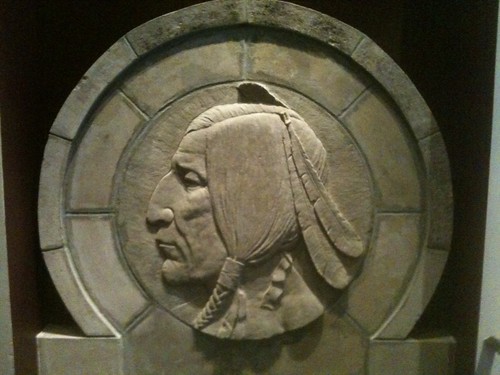
ARTICLE PROFILES COIN DEALER BELINDA DOWNIE
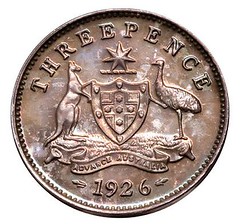 The managing director of Coinworks in Melbourne, Belinda Downie, has been involved in the rare-coin industry for 38 years. Among her career highlights have been placing the top three examples of Australia's first gold coin, the 1852 Adelaide Pound, and the sale of a Proof 1930 Penny for a record $620,000 in 2005.
The managing director of Coinworks in Melbourne, Belinda Downie, has been involved in the rare-coin industry for 38 years. Among her career highlights have been placing the top three examples of Australia's first gold coin, the 1852 Adelaide Pound, and the sale of a Proof 1930 Penny for a record $620,000 in 2005.
This was claimed as the world's most expensive copper coin but may not be for much longer. She has another Proof 1930 Penny for sale (currently under negotiation), this one from the celebrated collection of A.M. Le Souef, former deputy master of the Melbourne Mint. With an estimated value of $2 million, it is expected to set another record in due course.
Now she is announcing the sale of the Madrid Collection, arguably the foremost collection of Australian Proof and Pattern coinage in the world. The 50 items are valued in excess of $12 million. These will be sold privately, not by auction, in stages over the next few years. The first series of coins is available (see www.madridcollection .com.au) and a few of them have already been claimed.
The poster coin is the 1802 Madrid Holey Dollar, which gives the collection its name. This is the only example in private hands of a Holey Dollar converted from an eight reales coin struck at a Spanish continental mint (Seville or, in this case, Madrid).
The other five known are held by institutions. This one last appeared at the Spink Bicentennial Auction in March 1988.
The 1926 Proof Penny also featured is formerly part of the famous Ray Jewell Collection of Australian copper coins.
It was bought in 2001 for $21,500, setting a record for George V copper coins. Today's value is $115,000.
To read the complete article, see: Old coins worth a mint (www.smh.com.au/money/investing/old-coins-worth-a-mint-20101012-16gos.html)
PHOTO: ROMAN GOLD COINS FOUND IN GERMANY
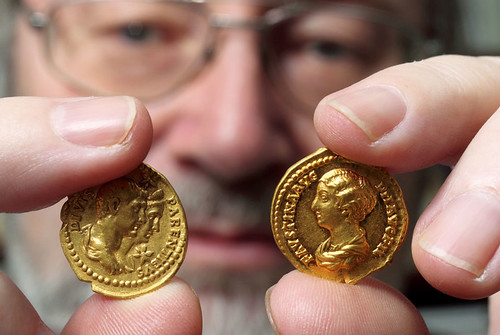
German numismatist and archaeologist Karl-Josef Gilles presenting two Roman gold coins discovered in 1993 at State Museum Trier, Germany. The complete Roman gold treasure, almost overlooked during construction works for an underground car park, is to be on display.
To read the complete article, see: The Best Photos of the Day (artdaily.org/index.asp?date=10/12/2010#images)
NOTES FROM E-SYLUM READERS: OCTOBER 17, 2010
Regarding author Richard Kenney, Eric Newman writes:
I examined my copy of the Richard D. Kenney article in the January - February 1952 Coin Collector's Journal. It has many annotations made by me including an article by Kenney in the July 1955 Numismatic Scrapbook.
I checked my correspondence file and find no letters from him or to him. I had great respect for his work.
Former ANA Librarian Nancy Green writes:
I can't resist commenting on the last E-Sylum: Digitizing the personal library.
As someone who has reached the age where downsizing is more attractive than collecting, I can identify with Halavais' need to condense his library. Indeed, every librarian struggles with the finite space of the library and the constant stream of new publications. One needs to find a way to retain the information but in a new form, not always the physical book or magazine. Obviously, one hopes that somewhere there is a complete copy of every book but realistically, probably not. Nor do all publications need to be preserved. New information is discovered and sometimes the previous information is so incorrect it represents a threat to health or safety.
I have books in my library which I preserve for the information and books I preserve because they are autographed by the author or just appeal to my aesthetic sense of beauty, but the law of physics is that two object cannot occupy the same space and so we all have to "get real" sooner or later.
The E-Sylum is a shining light in my week! Keep up the great work!
I was right, though, that the article would be upsetting to some bibliophiles. Denis Loring writes:
"Slice and scan." I think I'm going to puke.
To read the earlier E-Sylum article, see: DIGITIZING THE PERSONAL LIBRARY (www.coinbooks.org/esylum_v13n41a25.html)
David Lisot of Cointelevision.com writes:
I noticed the article on the Colonel Green collection inventory in the recent E-Sylum. Readers may be interested to know about the recent video lecture delivered by Peter Huntoon at the American Numismatic Association Numismatic Theatre presentation in Boston as part of the Maynard Sundman Littleton Coin Lecture Series.
He discussed the life and collecting of the famous son of Hetty Green and shared what he learned about the sale of the Colonel's collection including:
- Background of Hetty Green and how she made her money, and died in 1916
- How she started working out of the Chemical National Bank and what made her change banks
- Her son Colonel Edward H. R. Green, 1868-1936, and how he was so different from his mother
- Amputation of Ned's leg and why and how it happened
- Their involvement in the railroad industry and how Ned moved to Texas
- How he gained the title “Colonel”
- Changes in Ned's life after Hetty died in 1916 including his mansion, yacht, wife
- story of Ned's whale penis
- Research that he funded and why
- Green's incredible collection that included coins, stamps, jewelry and pornography
- Dispersal of the collection and what happened to the Green fortune
A DVD of the talk may be checked out for free to ANA members through the library at: money.org
To read the earlier E-Sylum article, see: COLONEL GREEN COIN COLLECTION INVENTORY SURFACES (www.coinbooks.org/esylum_v13n41a11.html)
After last week's "Lust in the Stacks" item I asked, "Is there a biblio equivalent of the Mile High Club?" Loren Gatch writes:
--Yes! There is (or at least was) something like that among grad students attending at least one Eastern research university...
Arthur Shippee adds:
The mind wanders & wonders: British Library; Vatican Library; New York Public Library; a clean-sweep of the Ivies; a clean-sweep of the 7 Sisters . . . .
To read the earlier E-Sylum article, see: LARRY MITCHELL ON LUST IN THE STACKS (www.coinbooks.org/esylum_v13n41a30.html)
FEATURED WEB PAGE: AUSTRIAN ENGRAVERS
This week's Featured Web Page is on Austrian Engravers. It is suggested by John and Nancy Wilson. Thanks!

If you have ANY literature with any information (no matter how small that amount is) about any Austrian Engraver (even ones not listed here); I would love a copy or a scan of that portion.
This list is alphabetical, FAR from complete, and the information presented is tentative. The dates after the names are the earliest and the latest dated coin, medal, plaque, plaquette, jetton or token (not necessarily made by the Austrian National Mint) that I have seen by that person unless the date is explained otherwise.
Most but certainly not all of the Artist, Sculptors, Engravers, or Medalists (whether Austrian or other) that I have listed on this site, at one time or the other, have worked for the Austrian Mint or designed one or more coins, medals or tokens for them or at least created an Austrian themed medal.
www.austriancoins.com/engravers.html
